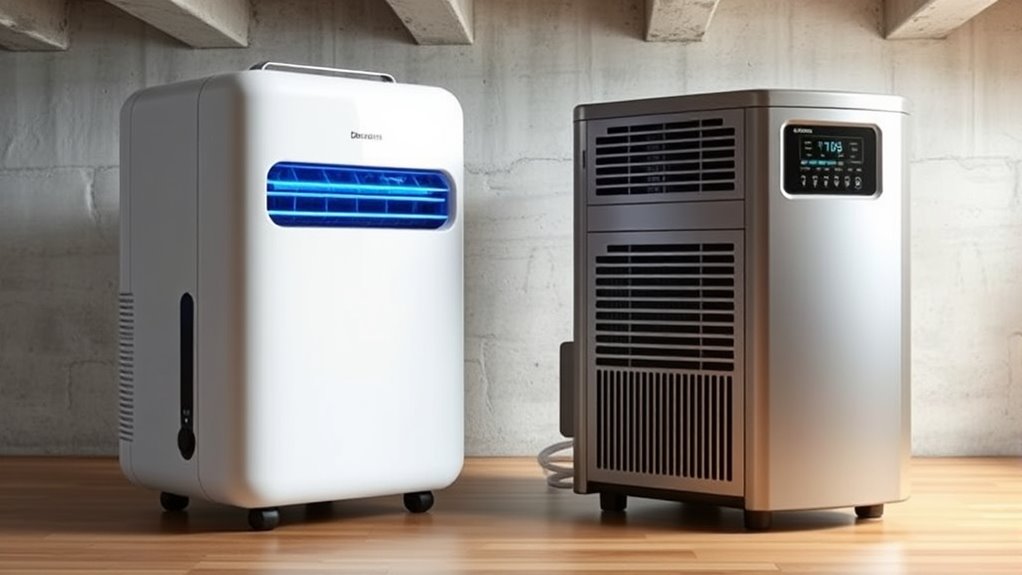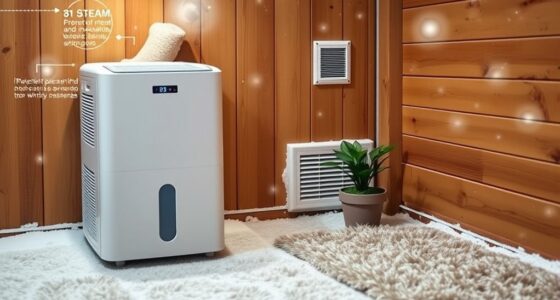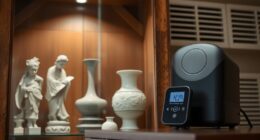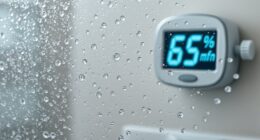If you’re choosing between desiccant and compressor dehumidifiers, consider your environment. Desiccant models perform better in low temperatures, operate quietly, and are ideal for unheated or cold spaces. Compressor units work efficiently in warm, humid conditions but can struggle in colder weather and tend to be noisier. For long-term value, energy use, and comfort, understanding their differences can help you pick the best fit—more details can guide your decision.
Key Takeaways
- Desiccant dehumidifiers excel at low temperatures and in unheated spaces, maintaining efficiency where compressor units struggle.
- Compressor dehumidifiers are more energy-efficient and cost-effective in warm, climate-controlled environments.
- Desiccant units operate quietly, making them ideal for bedrooms or quiet spaces, whereas compressor models tend to be noisier.
- Compressor dehumidifiers are generally less expensive upfront but less effective in cold conditions; desiccants offer better performance in cold weather.
- Overall performance depends on environment temperature, humidity levels, and specific use case requirements.
How Desiccant Dehumidifiers Work
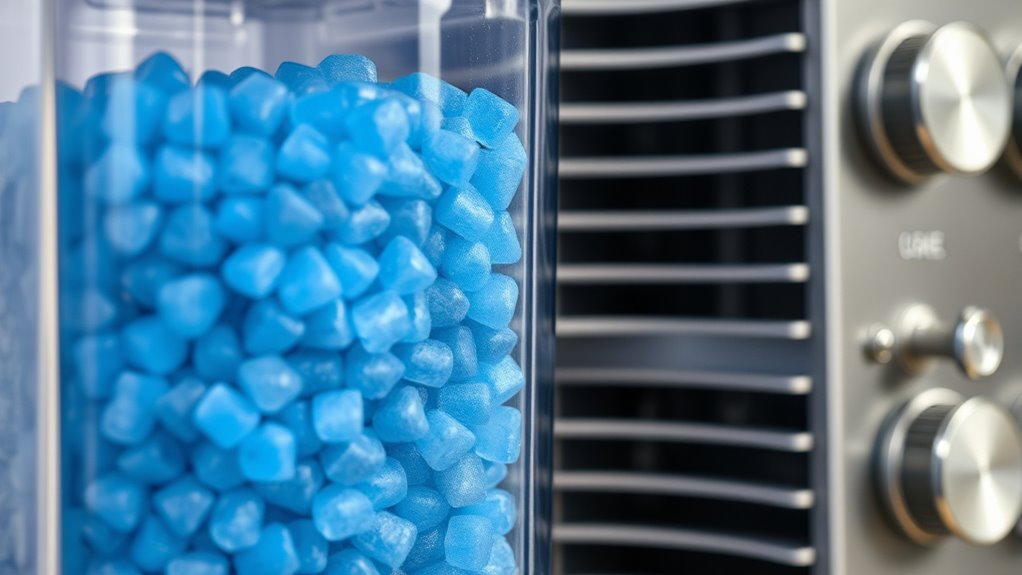
Desiccant dehumidifiers remove moisture from the air by using a material called a desiccant, which absorbs water vapor. These devices rely on hygroscopic materials—substances that attract and hold moisture efficiently. As air passes through the unit, the desiccant captures water molecules, reducing humidity levels. To maintain effectiveness, the desiccant undergoes regeneration, a process that involves removing absorbed moisture so it can be reused. This regeneration often occurs through heating or exposure to a dry environment, allowing the desiccant to regain its hygroscopic properties. Unlike compressor models, desiccant dehumidifiers operate silently and perform well in low temperatures, making them ideal for specific settings. Their ability to continuously absorb moisture hinges on effective desiccant regeneration, ensuring consistent dehumidification. Understanding the science behind desiccants helps explain their unique advantages in various conditions.
How Compressor Dehumidifiers Operate

Compressor dehumidifiers work by using a refrigeration cycle to remove moisture from the air. They compress air to increase its temperature and pressure, which helps in condensing out the water vapor. This process effectively extracts humidity, making your space drier and more comfortable. Additionally, the efficiency of this process can be influenced by factors such as contrast ratio, which impacts the device’s ability to differentiate moisture levels under various lighting conditions.
Refrigeration Cycle Mechanics
The refrigeration cycle at the heart of compressor dehumidifiers relies on a continuous process of compression, condensation, expansion, and evaporation. As the refrigerant circulates through these stages, it absorbs moisture from the air, helping with humidity control. The compressor compresses the refrigerant, raising its temperature and pressure. It then flows through the condenser coils, where it releases heat and condenses into a liquid. Next, an expansion valve reduces its pressure, cooling it rapidly. In the evaporator coil, the refrigerant absorbs heat from the surrounding air, causing moisture to condense on the coil’s surface. This process effectively removes moisture from the air, maintaining a balanced humidity level. The cycle repeats constantly, ensuring consistent moisture removal and ideal humidity control. Proper maintenance of the compressor and coils is essential for optimal refrigeration cycle performance and energy efficiency.
Air Compression Process
When a compressor dehumidifier operates, it actively compresses the refrigerant vapor to increase its pressure and temperature. This process is essential for humidity control, as it allows the refrigerant to release heat and condense moisture from the air. As the refrigerant moves through the system, it also aids in air filtration by removing airborne particles and contaminants. The compressor’s role is critical because it continuously cycles refrigerant, maintaining ideal humidity levels. Additionally, understanding local laws can influence how effectively a dehumidifier performs in different environments. Here’s a quick overview of the process:
| Step | Description |
|---|---|
| 1 | Compresses refrigerant vapor |
| 2 | Raises pressure and temperature |
| 3 | Condenses moisture |
| 4 | Releases heat to surroundings |
| 5 | Circulates refrigerant again |
This cycle ensures efficient moisture removal and clean air.
Moisture Extraction Method
As refrigerant circulates through the system, it actively extracts moisture from the air by absorbing water vapor during condensation. Inside the dehumidifier, compressor components compress the refrigerant, raising its temperature and pressure. This hot, high-pressure refrigerant then flows through the condenser coil, where it cools and releases heat, causing moisture to condense on the coil’s surface. The condensed water drips into a collection tank. Unlike desiccant materials that absorb moisture directly, compressor dehumidifiers rely on this refrigeration cycle to remove humidity efficiently. The key to this process is the compressor, which maintains continuous circulation and pressure changes, enabling rapid moisture extraction. This method is highly effective in high-humidity environments, providing consistent, energy-efficient dehumidification.
Energy Efficiency and Operating Costs
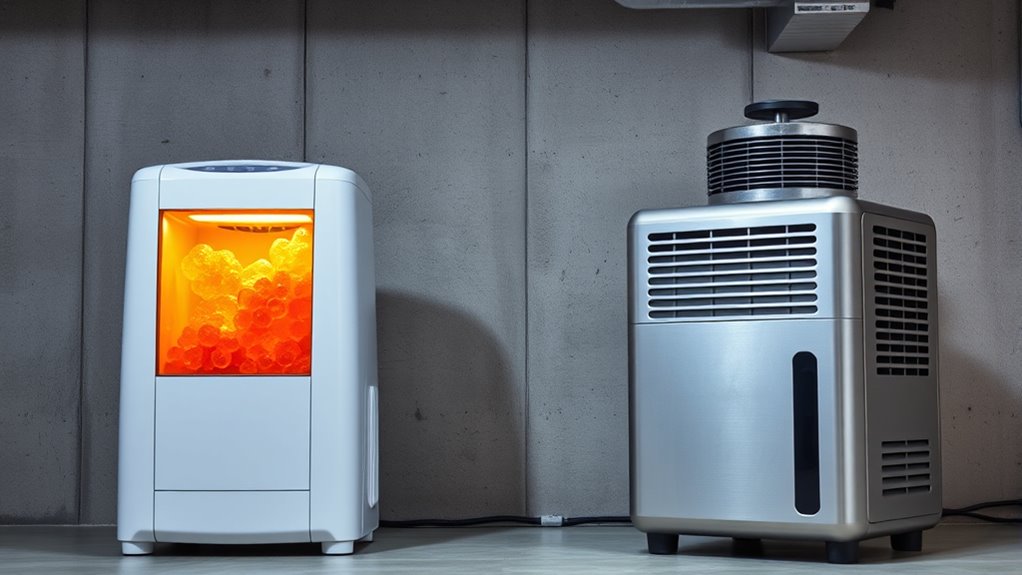
Choosing between desiccant and compressor dehumidifiers often hinges on their energy efficiency and operating costs. Desiccant models typically have higher power consumption because they rely on heat to regenerate the desiccant material, which can increase your operating expenses over time. In contrast, compressor dehumidifiers usually use less energy, making them more cost-effective for continuous use. However, their efficiency drops in colder temperatures, which can lead to increased power usage in such conditions. If you’re looking to minimize operating expenses, compressor units generally offer better energy efficiency in moderate temperatures. Conversely, if you need a dehumidifier that performs well in colder environments, a desiccant model might be worth the higher energy costs. Consider your climate and usage to make the best choice. Additionally, some Mazda Tuning upgrades emphasize enhancing overall vehicle performance and efficiency, paralleling the importance of selecting the right dehumidifier for your environment.
Performance in Different Temperature Ranges

When considering dehumidifiers for different climates, you’ll notice that cold weather can impact their efficiency differently. Desiccant models often perform better in low temperatures, while compressor units may struggle in chilly conditions. In warm climates, both types usually operate effectively, but understanding their strengths helps you choose the right one. Additionally, desiccant dehumidifiers are often more suitable for low light environments like basements or storage rooms, further enhancing their performance in colder settings.
Cold Weather Efficiency
Cold weather can critically impact the performance of dehumidifiers, and understanding how each type handles lower temperatures is essential. Desiccant dehumidifiers excel in cold environments because they don’t rely on condensation, maintaining effective humidity control even when temperatures drop. In contrast, compressor models struggle because their coils can freeze or become less efficient, reducing their environmental impact. When temperatures fall, you might notice decreased performance, especially with compressor units. Choosing the right dehumidifier for cold climates ensures better humidity management and minimizes energy waste.
- Desiccant units keep working efficiently in low temperatures
- Compressor models may freeze or lose effectiveness
- Humidity control remains stable with desiccants
- Environmental impact can be lower with efficient cold-weather units
- Proper choice enhances overall performance
Warm Climate Performance
In warm climates, dehumidifiers face different challenges and opportunities compared to cold environments. Humidity control becomes more demanding because higher outdoor temperatures increase moisture levels indoors. Desiccant dehumidifiers excel here because they perform consistently across a wide temperature range, making climate adaptation easier. They can operate effectively even in hot, humid conditions without losing efficiency. Compressor dehumidifiers, on the other hand, may struggle as high temperatures can reduce their performance and energy efficiency. If you need reliable humidity control in warm climates, a desiccant unit offers an advantage due to its stable operation. Understanding these differences helps you choose the right dehumidifier that adapts well to your climate, ensuring better comfort and moisture management year-round.
Suitability for Residential vs. Commercial Use

Desiccant and compressor dehumidifiers each serve different needs depending on whether they’re used in residential or commercial settings. For residential suitability, you’ll find compressor units ideal for everyday moisture control, offering quiet operation and ease of use. In contrast, desiccant dehumidifiers excel in specific environments like basements or unheated spaces. When it comes to commercial applications, desiccant models are preferred for their ability to perform well in low temperatures and larger spaces, making them suitable for warehouses or industrial facilities. Conversely, compressor dehumidifiers are often used for standard commercial humidity control in warmer, climate-controlled environments. Consider these factors:
- Residential spaces benefit from quieter, compact units
- Commercial applications demand higher capacity units
- Desiccant units handle low temperatures better
- Compressor models suit warm, climate-controlled areas
- Both types serve distinct needs effectively
Noise Levels and User Comfort

While both desiccant and compressor dehumidifiers aim to reduce moisture, their noise levels substantially impact user comfort. In a sound level comparison, desiccant units tend to operate more quietly, making them ideal for bedrooms or quiet spaces. Compressor dehumidifiers, however, often produce louder operational sounds, which can interfere with daily activities or sleep. Your user comfort considerations should include how noise affects your environment and routines. If you prefer a quieter device, a desiccant dehumidifier may be the better choice. Conversely, if noise isn’t a major concern and you need higher capacity, a compressor model might suit your needs. Overall, understanding sound levels helps you select a dehumidifier that maintains comfort while effectively controlling humidity. Additionally, RMDs can influence how you choose a dehumidifier if you are planning for long-term use or specific health considerations.
Maintenance and Longevity

Maintenance requirements and the longevity of dehumidifiers vary considerably between desiccant and compressor models. Desiccant units often need less frequent filter changes, thanks to their simpler design, but their parts may wear out faster, increasing repair frequency. Compressor models typically require regular filter replacements to maintain ideal performance, impacting filter lifespan. You’ll find that desiccant dehumidifiers tend to last longer if properly maintained, while compressor units may need repairs more often due to their mechanical components. Properly maintaining indoor air quality can also extend the lifespan of your dehumidifier.
Cost and Value for Money

When comparing costs, desiccant dehumidifiers often have higher upfront prices but can offer better long-term value in specific environments. Their initial price comparison tends to favor compressor models, which are generally cheaper initially. However, desiccant units tend to be more energy-efficient at lower temperatures, saving you money over time in cold or unheated spaces. Consider warranty coverage, too—desiccant dehumidifiers often come with longer or more detailed warranties, adding to their overall value. While the initial investment might seem steep, their durability and efficiency in certain conditions can make them more cost-effective long-term. Additionally, energy efficiency in cold environments can significantly influence the overall cost savings of a dehumidifier. Ultimately, your environment and usage frequency will influence which type provides better value for your money.
Choosing the Right Dehumidifier for Your Needs

Choosing the right dehumidifier depends on your specific environment and how you plan to use it. Consider factors like room size, humidity levels, and whether you need it for continuous use. Energy consumption is important—desiccant units often use less power in colder conditions, while compressor models excel in larger, warmer spaces. Noise levels also matter; some dehumidifiers operate quietly enough for bedrooms, while others may be louder. Think about how you’ll use the device daily and what features matter most.
- Room size and humidity needs
- Energy efficiency and power consumption
- Noise levels during operation
- Portability and size
- Maintenance and filter requirements
Frequently Asked Questions
Which Dehumidifier Type Is More Environmentally Friendly?
When choosing a dehumidifier, you consider which type is more environmentally friendly. You’ll want to look at energy efficiency, as lower power use reduces your carbon footprint. Material sustainability also matters—opt for models made with eco-friendly materials that last longer and generate less waste. Generally, compressor dehumidifiers tend to be more energy-efficient for larger spaces, while desiccant models might use less energy in smaller areas, helping you make a greener choice.
How Do Dehumidifiers Affect Indoor Air Quality?
Dehumidifiers improve indoor air quality by controlling humidity levels, which helps prevent mold, dust mites, and bacteria growth. This enhances air purification, making the air clearer and healthier to breathe. Proper humidity control also reduces musty odors and allergens. By removing excess moisture, you create a more comfortable environment, especially for allergy sufferers. Regular use of a dehumidifier keeps your indoor air fresh, clean, and easier to breathe.
Can Desiccant Dehumidifiers Operate Effectively Outdoors?
Imagine uncovering a secret weapon for outdoor humidity control—you might wonder if desiccant dehumidifiers can truly handle the elements. They excel in weather resilience, offering excellent outdoor durability even in fluctuating temperatures and humidity. While they can operate outside, their efficiency might decrease in extreme weather. If you need a reliable solution for outdoor spaces, desiccant dehumidifiers could surprise you with their resilience and performance.
Are There Any Health Risks Associated With Each Type?
You might worry about health risks from dehumidifiers, but generally, both types are safe when properly maintained. Allergies could be triggered if mold or dust accumulates, so regular cleaning helps. Noise levels vary; compressor models tend to be louder, which might bother sensitive users. Desiccant units often operate more quietly, making them better for bedrooms. Always check for filters and keep your device clean to minimize any allergy concerns or noise issues.
How Do Initial Setup Requirements Differ Between the Two?
Did you know that desiccant dehumidifiers often require less power, making them more energy-efficient? When setting up, you’ll notice power supply differences: compressor models need a standard outlet, while desiccant units might require a higher voltage. Installation complexity also varies—compressor dehumidifiers are generally straightforward to install, whereas desiccant units may need extra space or specific positioning for ideal performance. Consider these factors to simplify your setup process.
Conclusion
When choosing between desiccant and compressor dehumidifiers, consider your specific needs. Did you know desiccant units work effectively even at low temperatures, making them ideal for winter conditions? If you prioritize energy savings and quiet operation, a compressor model might suit you better. Ultimately, understanding each type’s strengths guarantees you pick the right dehumidifier, saving you money and ensuring comfort in your space. Make an informed decision—your ideal humidity level is within reach!
